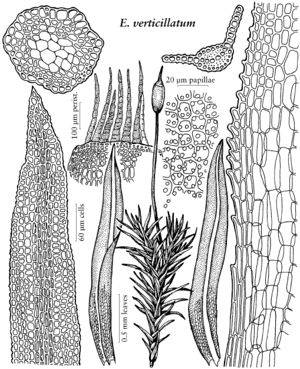Eucladium
Bryol. Europ. 1: 93. 1846 ,.
| Taxon | Illustrator ⠉ | |
|---|---|---|
 | Eucladium verticillatum | Patricia M. Eckel |
Plants small, in dense to deep tufts, turfs or swollen cushions, tufa-forming, bright to dark blue-green distally and pale green to yellowish-brown proximally or sometimes throughout, rarely rufous; frequently bleached or whitened and indurated with encrusted lime. Stems slender, branching irregularly, densely foliate in whorls at successive innovations; transverse-section rounded-pentagonal with an irregularly inflated or enlarged hyalodermis and weakly developed sclerodermis; central strand absent; weakly radiculose, rarely strongly so; axillary hairs of 5–10 cells, hyaline throughout. Leaves appressed and scarcely incurved-contorted when dry, erect-spreading when moist, oblong to mostly linear-lanceolate or linear-subulate, base undifferentiated in shape to occasionally broadened-oblong; margins plane, entire except for distinctive irregular hollow teeth on shoulder just distal to the base, not bordered; apex broadly to narrowly acute or subulate; costa strong, percurrent to shortly excurrent as a stout mucro, in transverse-section elliptic; adaxial surface cells quadrate to elongate, adaxial epidermis present, adaxial stereid band, medial guide cells and abaxial stereid band present, abaxial epidermis sometimes absent, hydroid strand absent; basal-cells sharply differentiated across to the margin where they become narrower, elongate, bulging-rectangular to rhomboidal, hyaline, smooth, lax and thin-walled; distal laminal cells subquadrate, walls sometimes irregularly thickened, papillae low, indistinct, simple or 2-fid, several per cell. Specialized asexual reproduction reportedly by rhizoidal brood bodies. Sexual condition dioicous; perigonia terminal, interior leaves longlanceolate, similar to those of the stem; perichaetia terminal, leaves as in stem-leaves, ovatelanceolate, to 2.5 mm and sheathing. Seta to 8 mm, single, erect. Capsule erect, symmetrical, yellowbrown, ovoid to cylindrical; annulus weakly developed, of ca. 2 rows of subvesiculose cells; operculum obliquely conic-rostrate; peristome teeth 16, straight or slightly oblique, lanceolate, finely papillose, entire to variously cleft. Calyptra cucullate, smooth. Spores 8–14 µm, spherical, mostly smooth. Laminal KOH color reaction yellow.
Distribution
North America, Mexico, Central America, Europe, Asia, Africa
Discussion
Species 1.
R. H. Zander (1993) removed Eucladium irroratum (Mitten) Jaeger to the genus Tetracoscinodon, rendering Eucladium monotypic and characterized by absence of stem central strand and sclerodermis, a somewhat enlarged hyalodermis, costa broad in relation to the leaf, plane margins with their peculiar dentition at the leaf shoulder (a condition that may be variable or rarely even absent), and terminal inflorescences. The generic placement is near Trichostomum (Zander). The genus is differentiated from other members of the former tribe Pleuroweisieae by the presence of a peristome, the distinctive serrulations on the proximal leaf margins, and the hyaline, thin-walled and bulging-rectangular differentiated basal cells (Zander 1977).